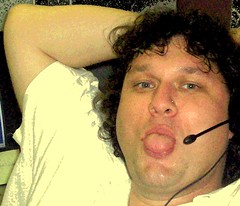
[Photo of Ranjit Hoskote by flickr user mshilman]
Griffith University's Griffith Asia Institute is putting on a free seminar with Indian poet, writer and curator Ranjit Hoskote at the Gallery of Modern Art this Thursday, March 4th 2010 at 5.30pm.
Hoskote will be talking about what creative artists are doing in India right now, and how they are thinking about their art. Hoskote is an Indian poet and art critic who writes in English. He's been critical of Western media and culture ignoring modern thought in the Islamic world:
The denial of contemporaneity to the Islamic world can sometimes proceed from the best intentions, as when invited experts cite and discuss the Holy Koran and the Sayings of the Prophet as the ultimate and armatural texts for present-day political choices. This approach creates the impression that Islamic civilisation has made no further contribution to the history of thought since the 7th century; it also negates the role of secular philosophies in the evolution of the Muslim or Arab political consciousness. For instance, this writer cannot recall a single reference, in mainstream-channel discussions during the last 17 months, to Ali Shariati, the political visionary and critic of consumption capitalism whose teachings provided the stimulus for the first, 1978 phase of the Iranian Revolution. Or to the historian of science and gnosis, Seyyed Hossein Nasr; or the Egyptian secular revolutionary, Gamal Abdel Nasser, or the Algerian socialists Ahmed Ben Bella and Houari Boumediene. The Libyan leader Muammar al-Gaddafi is usually mentioned only in the context of the Lockerbie case or dismissed as a maverick; his contribution to post-colonial praxis goes unremarked. These and many other thinkers and political figures from the world of Islam have been consigned to oblivion by the global media; the modernities they symbolise, their conceptions of freedom, justice and the scope of human possibility, are rendered invisible.Hoskote has also been strongly critical of attacks on cultural expression by religious mobs and bigoted police:
The outrageous arrest of Chandramohan, a final-year fine arts student at the Maharaja Sayajirao University, Baroda, on May 9, has confirmed that the only right that is taken seriously in India today is the right to take offence. The right to take offence is not a fundamental right guaranteed by the Constitution, but all the same, it is the most easily enforced of all rights. All you need is a local demagogue with a taste for publicity, a few rampaging goons, policemen who favour the violent over the reasonable, and a lower judiciary that is reluctant to defy the mob.And also here:
Chandramohan, who was taken into custody by the Baroda police without a proper warrant, after he had been roughed up by a gang of Vishwa Hindu Parishad (VHP) activists, has been charged with public obscenity and an attempt to incite communal disharmony. The images to which such turbulent opposition has been mounted show a woman, perhaps a goddess, birthing a man (which is no more fearful than the Lajja-gouri of Hindu sacred art), and a crucifix with a penis (this, an obvious homage to Robert Mapplethorpe). Both images retrieve the passionate human dramas that lie at the core of sacred narratives. Both images insist upon the artist’s right to revisit inherited lore, to reinvent images and narratives, to integrate the sacred as an element of secular experience.
The Bajrang Dal and Vishwa Hindu Parishad activists who attacked the Garden Art Gallery in Surat, on January 29, appear to have taken destructive criticism to its extreme. Labouring under the delusion that the Hindu pantheon required defence against artistic blasphemy, these ruffians destroyed eight works by distinguished contemporary Indian painters including M. F. Husain, K. H. Ara and N.S. Bendre, and the younger Kolkata artist, Chittrovanu Mazumdar. This manifestation of a terrifyingly illiberal tendency, which has come to dominate our public life, flagrantly challenges the Constitutional right to the freedom of expression. Conversely, it champions the self-arrogated right to take violent offence at affronts, real or imagined, to belief or identity.
The Surat outrage follows the model set by the Sambhaji Brigade's rampage through Pune's Bhandarkar Oriental Research Institute on January 5. Far from being aberrations, these incidents are continuous with a shameful series of violations of artistic and scholarly freedom in the recent past. These precedents include the vilification campaign launched by various Hindu-majoritarian organisations, during 1996, against Husain for his alleged portrayal of a nude Saraswati; the disruption of the Pakistani vocalist, Ghulam Ali's Mumbai concert by the Shiv Sena, in 1998; the demonstrations by Rashtriya Swayamsevak Sangh (RSS) auxiliaries in Varanasi, which forced Deepa Mehta to stop work on her film, Water, in 2000; and the withdrawal of an exhibition by Pakistani artists at Mumbai's Sakshi Gallery in 2001, under Sena pressure.
(Shiv Sena is a right-wing Indian political party allied with the Hindu-supremacist movements in India.)
In this interview with Clark Blaise of the University of Iowa, from 1995, Hoskote reads some of his poetry and discusses what it's like to be an Indian poet writing in English when there's pressure to not use this language:
Ranjit Hoskote interviewed by University of Iowa's Clark Blaise 950101 by djackmanson
If you'd like to go to the seminar, email Natasha Vary at n.vary@griffith.edu.au. The Gallery of Modern Art is in the Cultural Centre at Southbank, and the seminar is in Cinema B. The best way to get there by public transport is to catch a bus to the Cultural Centre bus station or a train to South Brisbane train station and walk to the Gallery - click here for a Google Map. To check bus and train timetables, click here to use the Translink journey planner.

No comments:
Post a Comment